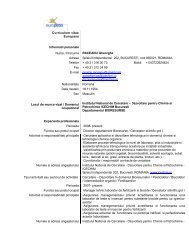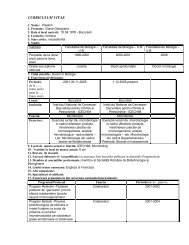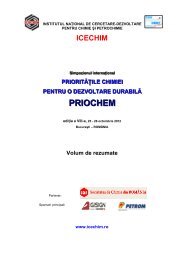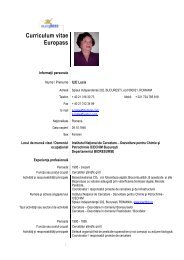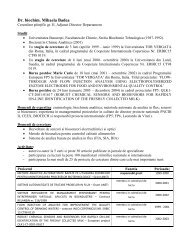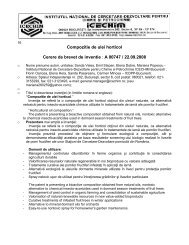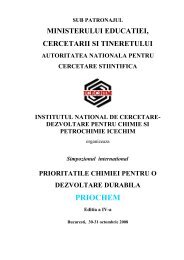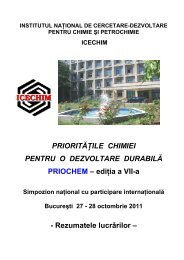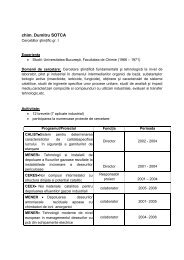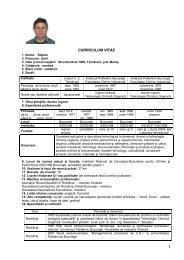Biomasa este un termen generic care cuprinde o ... - ICECHIM
Biomasa este un termen generic care cuprinde o ... - ICECHIM
Biomasa este un termen generic care cuprinde o ... - ICECHIM
Create successful ePaper yourself
Turn your PDF publications into a flip-book with our unique Google optimized e-Paper software.
100electrophoresis with Apoptotic DNA Ladder Kit (Roche). The viability of tumor cells loadedwith photosensitizer (TSPP) and irradiated, decrease after irradiation with raising of incubationtime. The proliferative capacity of loaded and irradiated cells is drastically reduced comparedwith <strong>un</strong>irradiated samples; besides this, the photosensitizier alone doesn’t affects neitherviability nor proliferative potential and this is a evidence of the fact that TSPP is a nonagresivcompo<strong>un</strong>d in relation to cellular physiology. The total RNA level is reduced in irradiatedsamples and is correlated with a poor incorporation of tritiated uridine in genome; thusirradiation interferes with multiplication of tumor cells. The K562 cells loaded with TSPP andirradiated enroll apoptosis relative rapidly after irradiation as characteristic fragmentation ofgenomic DNA is shown.5. In Vitro PHOTODYNAMIC ACTION OF METALLO- PHTHALOCYANINES ONSACCHAROMYCES CEREVISIAE CULTURE CELLSRodica-Mariana ION, Benoît DI STASIO, Céline FROCHOT*<strong>ICECHIM</strong>, Splaiul Independentei 202, Bucharest-79611, Romania; E-mail: irma@pcnet.ro** DCPR, UMR 7630 CNRS-INPL, Groupe ENSIC, 1 rue Grandville, 54000 Nancy, FrancePhotodynamic therapy (PDT) of cancer has been known for over twenty years and isbased on the dye-sensitized photooxidation of different biological targets in the tumoral tissue,yielding to a photochemically induced cell's death via mainly apoptotic pathways. Theeffectiveness of this therapeutic method depends on the photophysical and photochemicalproperties of the photosensitizer-drug.Photodynamic therapy (PDT) is a promising treatment modality. Since it has beenaccepted in clinics as a curative or palliative therapy for cancer and other nonmalignantconditions.Phthalocyanines are among the more promising second-generation photosensitizers.There has been considerable interest in phthalocyanines for use in PDT, mainly because oftheir high absorbance coefficient in the far red region of the light spectrum (670-700 nm), withoptimal tissue penetration by light. The photophysical properties of phthalocyanines arestrongly dependent on the central metal ion. Among the metal phthalocyanines, Zn II and Al IIIcomplexes (zinc phthalocyanine, ZnPC, and chloroaluminum phthalocyanine, AlPHCl)present the most favorable photophysical properties for application in PDT, that is to sayrelatively long-lived excited singlet states (ca. 3-8 ns) and long-lived triplet states that are



